生物专业英语试题附答案
- 格式:doc
- 大小:662.00 KB
- 文档页数:9
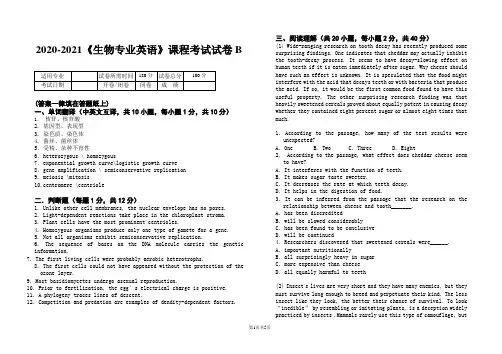
2020-2021《生物专业英语》课程考试试卷B(答案一律填在答题纸上)一、单词翻译(中英文互译,共10小题,每小题1分,共10分)1.核苷、核苷酸2. 基因型、表现型3. 染色质、染色体4. 菌丝、菌丝体5.受精、杂种不育性6.heterozygous \ homozygous7.exponential growth curve\logistic growth curve8.gene amplification \ semiconservative replication9. meiosis \mitosis10.centromere \centriole二.判断题(每题1分,共12分)1. Unlike other cell membranes, the nuclear envelope has no pores.2. Light-dependent reactions take place in the chloroplast stroma.3. Plant cells have the most prominent centrioles.4. Homozygous organisms produce only one type of gamete for a gene.5. Not all organisms exhibit semiconservative replication.6. The sequence of bases on the DNA molecule carries the geneticinformation.7. The first living cells were probably aerobic heterotrophs.8. The first cells could not have appeared without the protection of theozone layer.9. Most basidiomycetes undergo asexual reproduction.10. Prior to fertilization, the egg’s electrical charge is positive.11. A phylogeny traces lines of descent.12. Competition and predation are examples of dendity-dependent factors. 三、阅读理解(共20小题,每小题2分,共40分)(1) Wide-ranging research on tooth decay has recently produced some surprising findings. One indicates that cheddar may actually inhibit the tooth-decay process. It seems to have decay-slowing effect on human teeth if it is eaten immediately after sugar. Why cheese should have such an effect is unknown. It is speculated that the food might interfere with the acid that decays teeth or with bacteria that produce the acid. If so, it would be the first common food found to have this useful property. The other surprising research finding was that heavily sweetened cereals proved about equally potent in causing decay whether they contained eight percent sugar or almost eight times that much.1. According to the passage, how many of the test results wereunexpected?A. OneB. TwoC. ThreeD. Eight2. According to the passage, what effect does cheddar cheese seemto have?A.It interferes with the function of teeth.B.It makes sugar taste sweeter.C.It decreases the rate at which teeth decay.D.It helps in the digestion of food.3. It can be inferred from the passage that the research on therelationship between cheese and tooth_______.A. has been discreditedB. will be slowed considerablyC. has been found to be conclusiveD. will be continued4. Researchers discovered that sweetened cereals were______.A. important nutritionallyB. all surprisingly heavy in sugarC. more expensive than cheeseD. all equally harmful to teeth(2) Insect,s lives are very short and they have many enemies, but they must survive long enough to breed and perpetuate their kind. The less insect like they look, the better their chance of survival. To look “inedible”by resembling or imitating plants, is a deception widely practiced by insects .Mammals rarely use this type of camouflage, butThe stick caterpillar is well named. It is hardly distinguishable from a brown or green twig. This caterpillar is quite common and can be found almost anywhere in North America. It is also called “measuring worm” of “inchworm”. It walks by arching its body, then stretching out and grasping the branch with its front feet, then looping its body again to bring the hind feet forward. When danger threatens, the stick caterpillar stretches its body away from the branch at an angle and remains rigid and still, like a twig, until the danger has passed.Walkingsticks, or stick insects, do not have to assume a rigid, twiglike pose to find protection, they look like inedible twigs in any position. There are many kinds of walkingsticks, ranging in size from the few inches of the North American variety to some tropical species that may be over a foot long. When at rest their front legs are stretched out. Some of the tropical species are adorned with spines or ridges, imitating the thorny bushes or trees in which they live.Leaves also seem to be a favorite object for insects to imitate. Many butter flies can suddenly disappear from view by folding their wings and sitting quietly among the foliage that they resemble.1.What is the main subject of the passage?A.Catepillars that live in treesB.The feeding habits of insectsC.How some insects camouflage themselvesD.Insects that are threatened with extinction2.In lines 1, the word “enemies”refers to______.A.other creatures competing for spaceB.extreme weather conditionsC.creatures that eat insectsD.inedible insects3.According to the passage, how does the stick caterpillar make itself look like a twig?A.By holding its body stiff and motionlessB.By looping itself around a stickC.By changing the color of its skinD.By laying its body flat against a branch4.Which of the following is true of stick insects?A.They resemble their surroundings all the time.B.They make themselves look like other insects.C.They are camouflaged only when walking.D.They change color to make themselves invisible.5.Which of the following are not mentioned in the passage as objectsthat are imitated as a means of protection?A. ThornsB.FlowersC.LeavesD.Sticks6.In which paragraph does the author describe the way in which stickcaterpillars move?A.Paragraph oneB.Paragraph twoC.Paragraph threeD.Paragraph four(3) Most animals use more than one species as food. Therefore, theterm “food web”is a better description of food relationships than“food chain”. A food web is a complex feeding system that containsseveral food chains. For example, mice, rabbits, and deer eat plants.owls eat mice and rabbits. Mountain lions eat rabbits and deer. Thesefive species are parts of food chains that together form a food web.The first link in a food chain is always a green plant. Only organismswith chlorophyll, such as green plants can make food. for example,the first link aquatic food chains is algae. Most algae are microscopicgreen plants that produce food by photosynthesis. In photosynthesis,energy from sunlight converts carbon dioxide and water to sugar. Tinyfish in lakes, streams and oceans eat algae. In turn, these tiny fishare eaten by larger fish. The larger fish are eaten by still largerfish. The food supply for fish is made by algae. This food is thenpassed through the food chains as one animal eats another.Organisms may be divided into three groups based on how they obtainfood. These groups are producers, decomposer and consumer. Organismscontaining chlorophyll are producers. thus, green plants are producers. Animals that eat other animals and plants as consumers. Microbes, one-celled organisms that cause the decay of dead plantsand animals are decomposers. Since decomposers cannot make their ownfood, they are also consumers.1.The main purpose of the passage is to_______.A.determine which food chain is the most efficientB.describe the food network among plants and animalsC.explain the process of photosynthesis in green plantsD.appeal to conservationists to protect endangered plant species2.According to the author, what is a “food web”?______A. A complicated system of several food chainsB. A society that distributes foodC. The relationship of one green plants to anotherD. The device that spiders use to catch food3. Which of the following would most likely be the first link in a food chain?_____A. TermitesB. FishC. LionsD. Grass4. The author divides organisms according to______.A. how they use up energyB. how they obtain foodC. how much energy they require in order to moveD. whether they live on the land or in the sea5. Which of the following organism could not be a consumer as described in the passage?A. a microbeB. a rabbitC. a treeD. a fish(4) Lichens can be spectacular for anyone who cares to look ,but few people take the trouble. Often modestly colored and seemingly two-dimensional as they cling to whatever surface they find, they grow in the background; as though designed to be ignored. Yet they hold a special fascination for botanists, partly because they present mysteries still to be solved and partly because they do so many things so well.No casual observer of a lichen would ever suspect that it was a composite of interacting life forms. The seemingly uncomplicated lichen is actually composed of a fungus and a colony of algae (or blue green algae, which some scientists now consider to be bacteria). A few species even include all three of these diverse forms of life. A complete lichen is strikingly different from its separated partners in both appearance and biochemistry; many produce unique compounds which cannot be made by the component organisms alone.Lichens grow in almost every natural habitat imaginable, from deserts to tropical rain forests—even on the back of certain beetles in New Guinea and inside rocks(along with algae) in the otherwise barren dry valleys of Antarctica.Many species can not tolerate extreme heat, cold or dryness. Very few, however, can survive heavy air pollution, and many live only where the air is very clean. The disappearance of lichens from an area gives warning of a threatened environment.1. Which of the following would be the best title for the passage?_____A. The versatility and complexity of the lowly lichenB. The hidden characteristics of algae coloniesC. The disappearance of the lichen speciesD. The habitats of spectacular fungi2. The author states that lichens grow “as though designed to be ignored” because theyare______.A. not totally understood by botanistsB. troublesome to collect for the purposes of studyC. uncomplicated in their internal structureD. not easily noticed by observers3. According to the author, most people are unaware that lichen is a____.A. leafy plantB. class of simple bacteriaC. two-dimensional life formD. Combination of organisms4. The “unique”compounds mentioned in the second paragraph are produced_____.A. through the cooperative efforts of the lichen’s partsB. only under laboratory conditionsC. through one of the three possible processesD. once in the lichen’s life cycle5. The author implies that lichens might be used to____.A. find water sourcesB. destroy unwanted plant lifeC. test for air purityD. provide food in remote areas四、短文翻译(第1题18分,第2题20分,共38分)1.Difference Between Prokaryotes and EukaryotesTwo major classes of cells, prokaryotes and eukaryotes, exist in nature and both types are used in industrial fermentation processes. The cellular properties of the two types are different.Bacterial cells belong to prokaryotes, and fungal yeast, animal and plant cells belong to eukaryotes. Both are used in fermentation processes.Eukaryotic cells have a distinct nucleus surrounded by a membrane, nuclear DNA is associated with proteins and exists as a definite structures celled chromosomes. The cells also contain other structures or organelles having specific physiological or biochemical functions, such as mitochondria(线粒体) and enzymes associated with these organelles which, but, are found in the protoplasm(原生质)and plasma membrane of prokaryotes.In contrast, prokaryotes lack a well-defined nucleus so that thegenetic material in the form of double stranded DNA is not separated from Array other cell constituents by its own membrane. These cells also lack other specialized organelles present in eukaryotes. Bacteria may contain small DNA fragments (called plasmids) in addition to the single major genome.2.载体是一个复制子,其基因可保留在寄主细胞内,载体包括质粒和寄主于细菌的噬菌体。
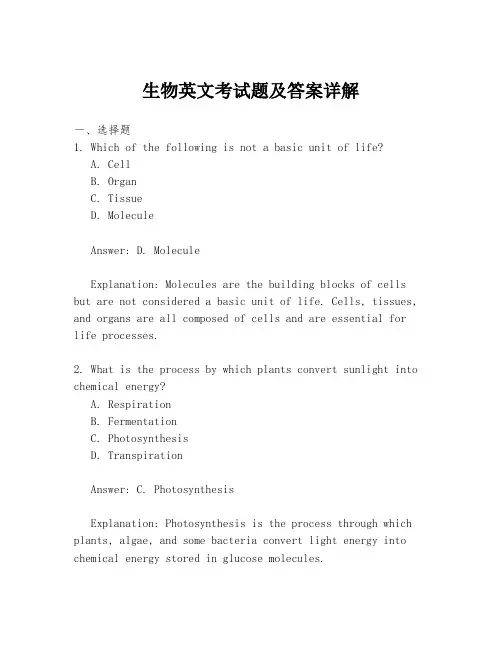
生物英文考试题及答案详解一、选择题1. Which of the following is not a basic unit of life?A. CellB. OrganC. TissueD. MoleculeAnswer: D. MoleculeExplanation: Molecules are the building blocks of cells but are not considered a basic unit of life. Cells, tissues, and organs are all composed of cells and are essential for life processes.2. What is the process by which plants convert sunlight into chemical energy?A. RespirationB. FermentationC. PhotosynthesisD. TranspirationAnswer: C. PhotosynthesisExplanation: Photosynthesis is the process through which plants, algae, and some bacteria convert light energy into chemical energy stored in glucose molecules.二、填空题1. The genetic material in all living organisms is either _______ or _______.Answer: DNA; RNAExplanation: DNA (deoxyribonucleic acid) and RNA (ribonucleic acid) are the two types of nucleic acids that carry genetic information in living organisms.2. The process of an organism developing from a fertilized egg to a mature individual is called _______.Answer: DevelopmentExplanation: Development refers to the series of changes that occur in an organism from the time of fertilization until it reaches maturity.三、简答题1. What are the main differences between prokaryotic and eukaryotic cells?Answer: Prokaryotic cells lack a nucleus and membrane-bound organelles, whereas eukaryotic cells have a defined nucleus and various membrane-bound organelles such as mitochondria and the endoplasmic reticulum.Explanation: The primary distinction between these two types of cells is the presence or absence of a nucleus. Prokaryotes, such as bacteria, have their genetic material dispersed in the cytoplasm, while eukaryotes, including plants and animals, have their genetic material enclosedwithin a nuclear membrane.四、论述题1. Discuss the role of DNA in the inheritance of traits.Answer: DNA, or deoxyribonucleic acid, is the molecule responsible for carrying genetic information in all living organisms. It contains the instructions needed for an organism to develop, survive, and reproduce. DNA is composed of four nucleotide bases: adenine (A), thymine (T), cytosine (C), and guanine (G). These bases pair up with each other (A with T, and C with G) to form a double helix structure. The sequence of these bases along the DNA molecule encodes the genetic information that determines an organism's traits. During reproduction, DNA is replicated and passed on to offspring, ensuring the inheritance of traits from one generation to the next.结束语:This examination paper has covered a range of topics in biology, from basic concepts to more complex processes, aiming to test the students' understanding and application of biological knowledge. It is hoped that through this test, students can identify areas for improvement and continue to deepen their study of biology.。
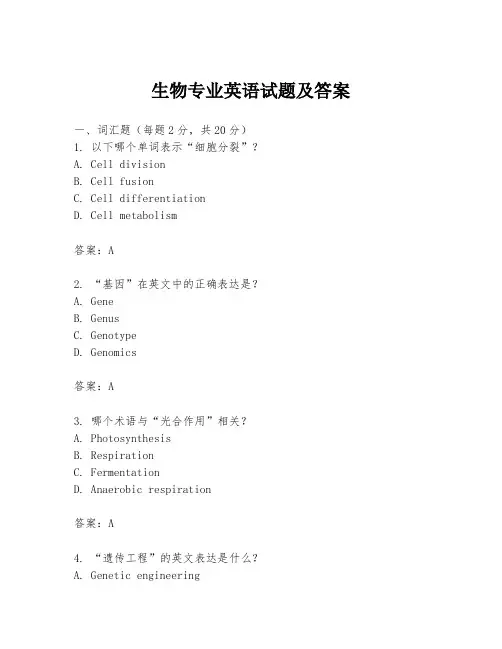
生物专业英语试题及答案一、词汇题(每题2分,共20分)1. 以下哪个单词表示“细胞分裂”?A. Cell divisionB. Cell fusionC. Cell differentiationD. Cell metabolism答案:A2. “基因”在英文中的正确表达是?A. GeneB. GenusC. GenotypeD. Genomics答案:A3. 哪个术语与“光合作用”相关?A. PhotosynthesisB. RespirationC. FermentationD. Anaerobic respiration答案:A4. “遗传工程”的英文表达是什么?A. Genetic engineeringB. Genetic mutationC. Genetic selectionD. Genetic variation答案:A5. “酶”的英文单词是?A. EnzymeB. HormoneC. ProteinD. Lipid答案:A6. “生态系统”在英文中如何表达?A. EcosystemB. BiosystemC. EcosystemsD. Biosphere答案:A7. “进化”的英文对应词是?A. EvolutionB. DevolutionC. InvolutionD. Revolution答案:A8. “克隆”在生物学中的英文术语是什么?A. CloningB. CopyingC. DuplicationD. Replication答案:A9. “物种”的英文单词是?A. SpeciesB. GenusC. VarietyD. Type答案:A10. “微生物”的英文表达是?A. MicroorganismB. MacroorganismC. OrganismD. Microbe答案:A二、阅读理解题(每题5分,共30分)阅读以下段落,并回答问题。
Biotechnology is the use of living organisms and bioprocesses to develop or make products. It involves the use of organisms, cells, and cellular components to research and produce goods and services. Modern biotechnology provides breakthrough products and technologies to combat debilitating and rarediseases, reduce our environmental footprint, feed the hungry, use less and cleaner energy, and have safer, cleaner and more efficient industrial manufacturing processes.11. 根据段落,生物技术涉及哪些方面?A. 使用生物和生物过程开发产品B. 仅使用生物过程C. 仅使用生物D. 使用生物和非生物过程答案:A12. 现代生物技术提供了哪些突破性的产品和技术?A. 治疗罕见疾病B. 减少环境影响C. 提供食物D. 所有上述选项答案:D13. 根据段落,生物技术如何帮助环境?A. 减少环境足迹B. 增加污染C. 加剧气候变化D. 消耗更多资源答案:A14. 生物技术如何帮助解决饥饿问题?A. 提供更少的食物B. 提供更多的食物C. 提高食物价格D. 降低食物质量答案:B15. 生物技术在工业制造中的作用是什么?A. 提高效率B. 降低安全性C. 增加污染D. 减少清洁度答案:A三、完形填空题(每题3分,共15分)阅读以下短文,从所给选项中选择最合适的一项填入空白处。
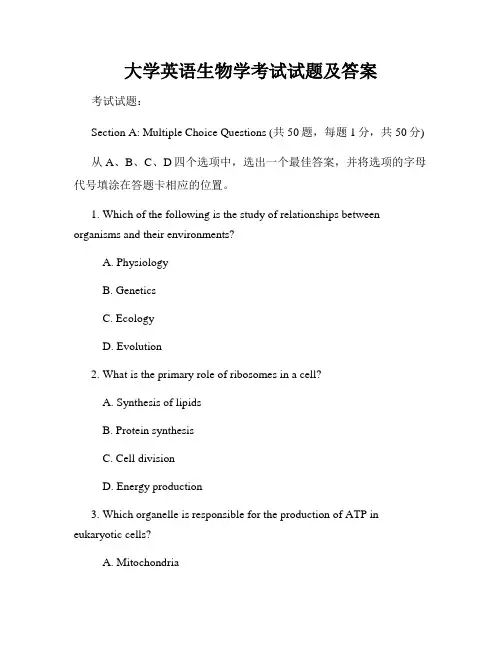
大学英语生物学考试试题及答案考试试题:Section A: Multiple Choice Questions (共50题,每题1分,共50分)从A、B、C、D四个选项中,选出一个最佳答案,并将选项的字母代号填涂在答题卡相应的位置。
1. Which of the following is the study of relationships between organisms and their environments?A. PhysiologyB. GeneticsC. EcologyD. Evolution2. What is the primary role of ribosomes in a cell?A. Synthesis of lipidsB. Protein synthesisC. Cell divisionD. Energy production3. Which organelle is responsible for the production of ATP in eukaryotic cells?A. MitochondriaB. Endoplasmic reticulumC. NucleusD. Golgi apparatus4. Which of the following is responsible for the transportation of water and nutrients in plants?A. PhloemB. XylemC. StomataD. Chloroplasts5. What is the function of the respiratory system in humans?A. Regulation of body temperatureB. Production of hormonesC. Exchange of gasesD. Elimination of waste products...Section B: Short Answer Questions (共5题,每题10分,共50分)根据题目要求回答问题,并将答案写在答题卡上。
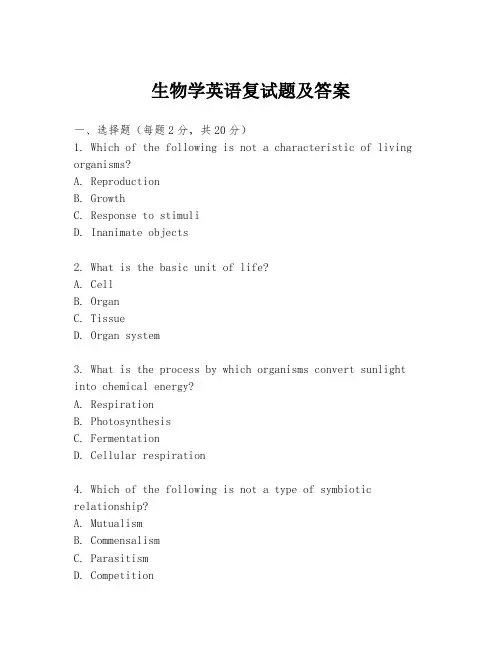
生物学英语复试题及答案一、选择题(每题2分,共20分)1. Which of the following is not a characteristic of living organisms?A. ReproductionB. GrowthC. Response to stimuliD. Inanimate objects2. What is the basic unit of life?A. CellB. OrganC. TissueD. Organ system3. What is the process by which organisms convert sunlight into chemical energy?A. RespirationB. PhotosynthesisC. FermentationD. Cellular respiration4. Which of the following is not a type of symbiotic relationship?A. MutualismB. CommensalismC. ParasitismD. Competition5. What is the term for the study of the structure of organisms?A. AnatomyB. PhysiologyC. EcologyD. Taxonomy6. What is the primary function of the mitochondria in a cell?A. Protein synthesisB. DNA replicationC. Energy productionD. Cell wall synthesis7. What is the term for the process by which new speciesevolve from existing ones?A. AdaptationB. Natural selectionC. SpeciationD. Genetic drift8. Which of the following is not a type of genetic mutation?A. DeletionB. InsertionC. DuplicationD. Mitosis9. What is the term for the study of the diversity of life on Earth?A. BiodiversityB. BiotechnologyC. BioinformaticsD. Biogeography10. What is the process by which organisms obtain nutrients from their environment?A. IngestionB. AssimilationC. DigestionD. Absorption二、填空题(每题2分,共20分)1. The scientific method involves making observations, forming hypotheses, conducting experiments, and then drawing ________.2. The genetic material in cells is composed of molecules called ________.3. The process by which organisms produce offspring that are similar to themselves is known as ________.4. In an ecosystem, the transfer of energy from one trophic level to the next is called ________.5. The study of the interactions between organisms and their environment is known as ________.6. The smallest unit of matter that retains the properties of an element is called a(n) ________.7. The process by which plants absorb water and nutrients from the soil is called ________.8. The study of the classification of organisms based ontheir evolutionary relationships is known as ________.9. The process by which organisms break down complex organic molecules into simpler ones is called ________.10. The study of the nervous system, including the brain,spinal cord, and nerves, is known as ________.三、简答题(每题10分,共40分)1. Explain the difference between asexual and sexual reproduction.2. Describe the role of DNA in the inheritance of traits.3. Discuss the importance of biodiversity for ecosystems.4. Explain how natural selection contributes to the evolution of species.四、论述题(20分)Discuss the impact of genetic engineering on modern agriculture and its potential ethical concerns.答案:一、选择题1. D2. A3. B4. D5. A6. C7. C8. D9. A10. A二、填空题1. Conclusions2. DNA3. Reproduction4. Energy flow5. Ecology6. Atom7. Absorption8. Phylogenetics9. Catabolism10. Neuroscience三、简答题1. Asexual reproduction involves a single organism producing offspring that are genetically identical to itself, while sexual reproduction involves the combination of genetic material from two organisms to produce offspring with a mix of traits from both parents.2. DNA carries the genetic information that determines the traits of an organism. It is passed down from parents to offspring during reproduction, allowing for the inheritance of specific characteristics.3. Biodiversity is crucial for ecosystems as it contributes to their stability, resilience, and ability to adapt to changes. It also supports a wide range of ecosystem services that are essential for human well-being.4. Natural selection is the process by which organisms that are better adapted to their environment are more likely to survive and reproduce, passing on their advantageous traits to their offspring. Over time, this leads to the evolution of species as traits that enhance survival and reproduction become more common.四、论述题Genetic engineering has revolutionized modern agriculture byenabling the development of crops with desirable traits such as disease resistance, pest resistance, and higher yields. However, it also raises ethical concerns regarding the potential impact on biodiversity, the possibility of creating "superweeds" or "superbugs," and the long-term health effects of genetically modified organisms on humans and the environment. It。
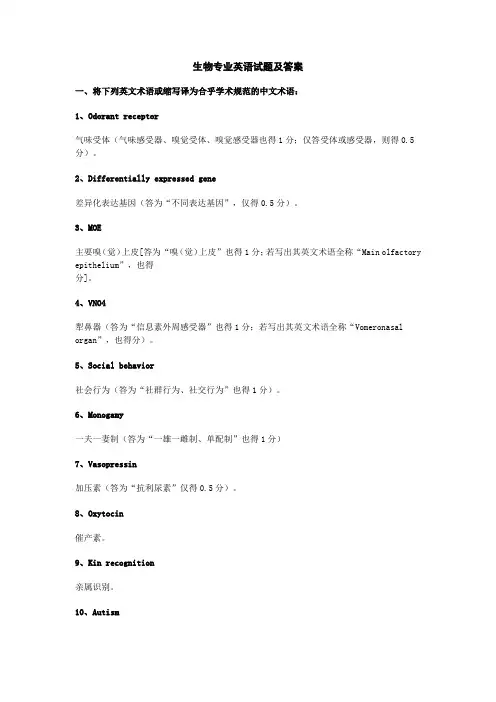
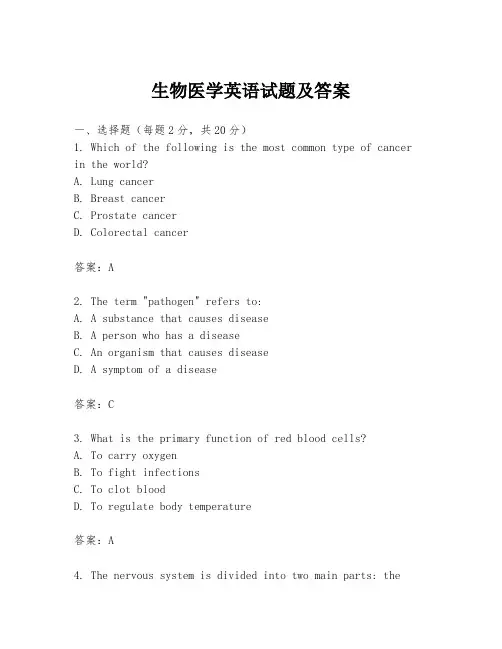
生物医学英语试题及答案一、选择题(每题2分,共20分)1. Which of the following is the most common type of cancer in the world?A. Lung cancerB. Breast cancerC. Prostate cancerD. Colorectal cancer答案:A2. The term "pathogen" refers to:A. A substance that causes diseaseB. A person who has a diseaseC. An organism that causes diseaseD. A symptom of a disease答案:C3. What is the primary function of red blood cells?A. To carry oxygenB. To fight infectionsC. To clot bloodD. To regulate body temperature答案:A4. The nervous system is divided into two main parts: thecentral nervous system and the:A. Peripheral nervous systemB. Autonomic nervous systemC. Sympathetic nervous systemD. Parasympathetic nervous system答案:A5. Which of the following is a characteristic of a viral infection?A. Presence of bacteria in the bloodB. Inflammation of the heartC. Infection by a virusD. Infection by a fungus答案:C6. The hormone responsible for the regulation of blood sugar levels is:A. InsulinB. Thyroid hormoneC. CortisolD. Adrenaline答案:A7. What is the term for the process by which the body maintains a stable internal environment?A. HomeostasisB. MetabolismC. Circadian rhythmD. Immunity答案:A8. The largest organ in the human body is:A. The brainB. The liverC. The skinD. The heart答案:C9. Which of the following is a type of connective tissue?A. Muscle tissueB. Nervous tissueC. Epithelial tissueD. Cartilage答案:D10. The process of cell division that results in two identical cells is called:A. MitosisB. MeiosisC. ApoptosisD. Cytokinesis答案:A二、填空题(每空1分,共20分)1. The study of the structure of organisms is called__________.答案:anatomy2. The process by which cells extract energy from nutrients is known as __________.答案:metabolism3. The basic unit of heredity is the __________.答案:gene4. The medical specialty that deals with the diagnosis and treatment of diseases of the heart and blood vessels is called __________.答案:cardiology5. The hormone that stimulates the growth and development of bones and muscles is __________.答案:growth hormone6. The study of the causes and effects of diseases is called __________.答案:pathology7. The body's response to injury or infection is known as__________.答案:inflammation8. The process by which the body gets rid of waste products is called __________.答案:excretion9. The largest gland in the human body is the __________.答案:liver10. The study of the nervous system is called __________.答案:neurology三、简答题(每题10分,共20分)1. Explain the role of the immune system in defending the body against infections.答案:The immune system plays a crucial role in defending the body against infections by recognizing and eliminating harmful pathogens such as bacteria, viruses, and otherforeign substances. It consists of various cells, tissues, and organs that work together to protect the body. When a pathogen enters the body, the immune system responds by activating white blood cells and producing antibodies that target and neutralize the invaders. This response helps to prevent the spread of infection and promotes healing and recovery.2. Describe the process of respiration in humans.答案:Respiration in humans is a process that involves the exchange of gases, primarily oxygen and carbon dioxide, between the body and the environment. It consists of two main stages: inhalation and exhalation. During inhalation, air containing oxygen is drawn into the lungs through the nose or mouth, then travels down the trachea and into the bronchi, which branch into smaller tubes called bronchioles. The bronchioles end in tiny air sacs called alveoli, where the exchange of gases occurs. Oxygen from the air diffuses across the thin walls of the alveoli into the bloodstream, where itbinds to hemoglobin in red blood cells. At the same time, carbon dioxide, a waste product of cellular respiration, diffuses from the blood into the alveoli. During exhalation, the diaphragm and intercostal muscles relax, causing the chest cavity to decrease in size and forcing the carbon dioxide-rich air out of the lungs. This cycle of inhal。
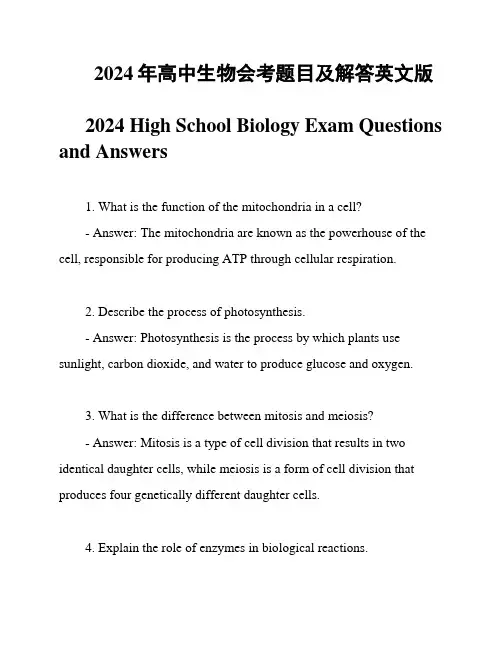
2024年高中生物会考题目及解答英文版2024 High School Biology Exam Questions and Answers1. What is the function of the mitochondria in a cell?- Answer: The mitochondria are known as the powerhouse of the cell, responsible for producing ATP through cellular respiration.2. Describe the process of photosynthesis.- Answer: Photosynthesis is the process by which plants use sunlight, carbon dioxide, and water to produce glucose and oxygen.3. What is the difference between mitosis and meiosis?- Answer: Mitosis is a type of cell division that results in two identical daughter cells, while meiosis is a form of cell division that produces four genetically different daughter cells.4. Explain the role of enzymes in biological reactions.- Answer: Enzymes act as catalysts in biological reactions, speeding up the rate of chemical reactions without being consumed in the process.5. How does the circulatory system function in the human body?- Answer: The circulatory system is responsible for transporting oxygen, nutrients, and waste products throughout the body using the heart, blood vessels, and blood.6. Discuss the importance of biodiversity in ecosystems.- Answer: Biodiversity is crucial for maintaining the balance of ecosystems, as it increases the resilience of the environment and provides various ecological services.7. What are the main differences between DNA and RNA?- Answer: DNA is a double-stranded molecule that stores genetic information, while RNA is a single-stranded molecule that helps in protein synthesis.8. Describe the process of protein synthesis.- Answer: Protein synthesis involves the transcription of DNA into mRNA, which is then translated into a specific sequence of amino acids to form proteins.9. Explain how natural selection leads to evolution.- Answer: Natural selection is the process by which organisms with advantageous traits are more likely to survive and reproduce, leading to changes in the genetic makeup of a population over time.10. What is the role of the immune system in the human body?- Answer: The immune system protects the body from pathogens and foreign invaders by recognizing and destroying them through a complex network of cells and proteins.This document provides a brief overview of the 2024 High School Biology exam questions and answers, covering various topics in the field of biology.。
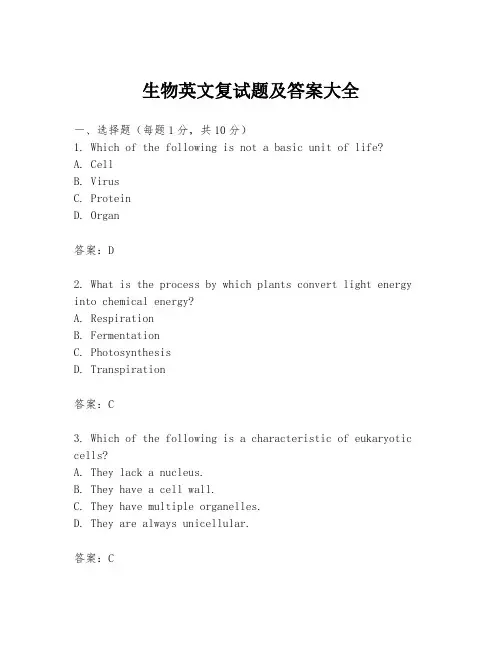
生物英文复试题及答案大全一、选择题(每题1分,共10分)1. Which of the following is not a basic unit of life?A. CellB. VirusC. ProteinD. Organ答案:D2. What is the process by which plants convert light energy into chemical energy?A. RespirationB. FermentationC. PhotosynthesisD. Transpiration答案:C3. Which of the following is a characteristic of eukaryotic cells?A. They lack a nucleus.B. They have a cell wall.C. They have multiple organelles.D. They are always unicellular.答案:C4. What is the primary function of DNA?A. To provide energy for the cell.B. To store genetic information.C. To protect the cell from damage.D. To regulate cell growth.答案:B5. Which of the following is a type of mutation?A. MitosisB. MeiosisC. TranslocationD. Anaphase答案:C6. What is the correct sequence of the biological classification hierarchy?A. Kingdom, Phylum, Class, Order, Family, Genus, SpeciesB. Species, Genus, Family, Order, Class, Phylum, KingdomC. Kingdom, Species, Genus, Family, Order, Class, PhylumD. Phylum, Class, Order, Family, Genus, Species, Kingdom 答案:A7. What is the term for the process by which an organism develops from a fertilized egg into a mature individual?A. GrowthB. DevelopmentC. DifferentiationD. Reproduction答案:B8. What is the main function of the mitochondria in a cell?A. To provide a barrier for the cell.B. To produce energy for the cell.C. To store genetic material.D. To regulate cell growth.答案:B9. What is the term for the study of the relationships among organisms?A. AnatomyB. PhysiologyC. PhylogeneticsD. Ecology答案:C10. Which of the following is a hormone?A. GlucoseB. InsulinC. ATPD. Cholesterol答案:B二、填空题(每题1分,共10分)11. The process by which an organism inherits traits from its parents is known as ______.答案:Inheritance12. The study of the structure of organisms is called ______. 答案:Anatomy13. The largest organ in the human body is the ______.答案:Skin14. The basic unit of heredity is the ______.答案:Gene15. The process by which organisms adapt to their environment is known as ______.答案:Adaptation16. The process of a plant absorbing water and nutrients is known as ______.答案:Absorption17. The scientific study of the natural world is called______.答案:Biology18. The process by which organisms produce offspring is known as ______.答案:Reproduction19. The study of the interactions between organisms and their environment is called ______.答案:Ecology20. The process by which an organism uses oxygen to break down glucose is known as ______.答案:Cellular Respiration三、简答题(每题5分,共20分)21. Explain the difference between a prokaryotic and a eukaryotic cell.答案:Prokaryotic cells lack a nucleus and membrane-bound organelles, while eukaryotic cells have a nucleus and various organelles enclosed within membranes.22. Describe the process of mitosis.答案:Mitosis is the process of cell division in which a single cell divides into two identical daughter cells, each with the same number of chromosomes as the parent cell. It includes stages such as prophase, metaphase, anaphase, and telophase.23. What is the role of chlorophyll in photosynthesis?答案:Chlorophyll is a pigment found in the chloroplasts of plant cells that absorbs light energy and uses it to convert carbon dioxide and water into glucose and oxygen, which are the energy source and byproduct of photosynthesis, respectively.24. Explain the concept of natural selection.答案:Natural selection is the process by which organismswith traits that are better suited to their environment are more likely to survive and reproduce, passing on those advantageous traits to their offspring.结束语以上是生物英文复试题及答案的汇总,希望能够帮助学生更好地复习和掌握生物学的基本概念和原理。

生物专业英语试卷答案(A)一.单词翻译(每题1分,共10分)1合子,受精卵、同源性,同种性 2死亡率、出生率3叶绿素、核酮糖二磷酸 4减数分裂、有丝分裂5等位基因、同源染色体对 6 photosynthesis ribosome7 diploid haploid 8 dominant recessive9 adenine cytosine 10 species regeneration二.判断题(每题1分,共10分)R, R, F, F, F, R,R,R, F, F三.阅读理解(每题2分,共40分)1 B、A、D、B、C2 A、D、D、A、C3 C、C、A、A、B、B4 B、C、D、D四.中英文互译(参考答案)(共40分)1.英文短句翻译成中文(每小题2分,共20分)(1)所有的真核生物细胞具有多种不同的细胞器,并且每种细胞器都有特定的作用。
(2)光合作用只能发生于绿色植物,藻类,某些原生生物和细菌等含有叶绿素的细胞中。
(3)生物体染色体螺旋化、浓缩化状态的图形表示被称为染色体组型。
在大多数细胞中,染色体组型显示出除性染色体外的所有染色体都是成对出现的,也就是同源染色体对。
(4)在一个性状上,生物体从每个亲本继承相同的等位基因,在这个性状上就是纯合的。
如果继承了不同的等位基因,在这个性状上生物体就是杂合的。
(5)前导链是连续合成的,而后随链是以短的直线状的冈崎片段合成。
(6)分类学大量揭示了关于生物间的进化关系。
一个进化枝是分类学上的一个单元,它的成员起源于一个共同的祖先。
(7)所有的真菌行使胞外的消化作用:它们分泌酶,消化有机物质,然后吸取产生的养分。
(8)器官发生过程中,当胚胎内部和表面的细胞特化时,胚胎的器官和组织形成。
(9)覆盖在广阔地理范围的一个物种的种群通常以梯度变异分布—梯度变异是指每个种群在进化适应它自身的本地环境时,在一个或多个性状上的逐渐变化。
(10)在一个群落中,正如竞争,捕食,和其他的因素相互作用来决定种群的大小一样,种群分布也是很多相关因素的结果。

生物专业英语课后练习题含答案1. Multiple Choice1.Which of the following is the most important considerationwhen designing a polymerase chn reaction (PCR)?A. The length of the primerB. The temperature of the PCRC.The amount of DNA in the sample D. The thermal stability of the DNA polymeraseAnswer: D2.Which of the following describes the function of arestriction enzyme in molecular biology?A. Restriction enzymes are used to replicate DNA.B.Restriction enzymes are used to sequence DNA. C. Restrictionenzymes are used to cut DNA at specific sites. D. Restrictionenzymes are used to amplify DNA.Answer: C3.The gel electrophoresis separates DNA fragments according towhich of following parameters?A. SequenceB. SizeC. ConcentrationD. ChargeAnswer: B4.Which of the following is not a component of a typicalprokaryotic cell?A. NucleusB. Cell wallC. RibosomeD. PlasmidAnswer: A5.Which of the following is responsible for the majority ofoxygen production on Earth?A. FungiB. AlgaeC. ProtozoaD. BacteriaAnswer: B2. Short Answer1.What is the difference between genotype and phenotype?Genotype refers to the set of genes an organism carries, while phenotype refers to the observable trts that result from the interaction between the organism’s genes and its environmen t.2.Describe the process of translation.Translation is the process by which the information encoded in mRNA is used to synthesize a protein. It occurs on ribosomes, which contn two subunits (the small subunit and the large subunit).The process begins with the small subunit binding to the mRNAmolecule; this initiates the process of recognition of the start codon (AUG). Once the start codon is identified, the ribosome will recruit the first tRNA (transfer RNA) molecule, which carries an amino acid. The amino acid is then added to the growing peptide chn as the ribosome moves along the mRNA molecule, one codon at a time. This continues until a stop codon is reached, at which point the ribosome releases the newly synthesized protein, and the mRNA molecule is degraded.3.What is the difference between prokaryotic and eukaryoticcells?Prokaryotic cells are simpler in structure than eukaryotic cells and do not have a nucleus or membrane-bound organelles. They are typically much smaller than eukaryotic cells. Eukaryotic cells, on the other hand, have a nucleus and many membrane-boundorganelles (such as mitochondria, chloroplasts, and theendoplasmic reticulum). They are generally larger and more complex than prokaryotic cells.3. True or False1.Bacteria are always harmful to humans.False2.The most diverse group of organisms on Earth is arthropods. True3.The Calvin cycle is the process by which photosynthesisoccurs.True4.Fungi are eukaryotic organisms that are primarilydecomposers.True5.RNA splicing removes introns from the primary RNA transcript,leaving only exons.True4. MatchingMatch the following terms with their correct definition or function:1.EnzymeC. Protein molecule that acts as a catalyst in a biochemicalreaction2.GlycolysisD. The process by which glucose is broken down into pyruvate3.MitochondriaA. Organelle responsible for cell respiration4.NucleusB. Organelle responsible for the storage and transmission ofgenetic informationAnswer:1.C2.D3.A4.BConclusionThis set of practice questions is designed to test your understanding of some of the key concepts in biology. By exploringtopics like genetics, cell structure, and molecular biology, you can gn a deeper appreciation for the complexity and diversity of life on Earth.By engaging with these questions and testing your knowledge, you can become a more confident and capable biologist.。
生物专业英语试题及答案一、将下列英文术语或缩写译为合乎学术规范的中文术语:1、Odorant receptor气味受体(气味感受器、嗅觉受体、嗅觉感受器也得1分;仅答受体或感受器,则得0.5分)。
2、Differentially expressed gene差异化表达基因(答为“不同表达基因”,仅得0.5分)。
3、MOE主要嗅(觉)上皮[答为“嗅(觉)上皮”也得1分;若写出其英文术语全称“Main olfactory epithelium”,也得分]。
4、VNO4犁鼻器(答为“信息素外周感受器,,也得1分;若写出其英文术语全称“Vomeronasal organ”,也得分)。
5、Social behavior社会行为(答为“社群行为、社交行为”也得1分)。
6、Monogamy一夫一妻制(答为“一雄一雌制、单配制”也得1分)7、Vasopressin加压素(答为“抗利尿素”仅得0.5分)。
8、Oxytocin催产素。
9、Kin recognition亲属识别。
10、Autism自闭症/孤独症。
11、NIH (美国)国家(立)卫生研究院(所X若写出其英文术语全称NIH = National Institutes of Health也得分)。
12、HHMI霍华德•休斯医学研究所(若写出其英文术语全称HHMI = Howard Hughes Medical Institute也得分;或者译为Howard Hughes医学研究所,也得全分)。
13、Nanotechnology纳米技术(纳米科技、奈米技术、奈米科技)。
阳光大学生网14、Renewable energy可再生能源(量)(答为“可更新能源、再生能源”,或意思相近者,也得1分)。
15、Biomechanical energy生物机械能(答为“生物力能、生物力学能”也得1分,而“生物化学能、生物能”,则得0.5 分)16、Nanogenerator纳米发电机(答为“纳米发动机、纳米电机、纳米发生器、纳米生产器”,也得1分)。
生物英语测试题及答案解析一、选择题(每题2分,共20分)1. What is the basic unit of life?A. CellB. OrganC. TissueD. System2. Which of the following is not a characteristic of living organisms?A. GrowthB. ReproductionB. Response to stimuliD. Inability to move3. What is the process by which plants make their food?A. RespirationB. PhotosynthesisC. FermentationD. Digestion4. In the field of genetics, what does the term "gene" refer to?A. A unit of heredityB. A type of proteinC. A form of energyD. A cell structure5. Which of the following is a type of mutation?A. Natural selectionB. Genetic driftC. Chromosomal mutationD. All of the above6. What is the function of chlorophyll in plants?A. To store waterB. To provide energy for photosynthesisC. To protect against sunlightD. To store nutrients7. What is the term for the study of the relationships among living organisms?A. AnatomyB. PhysiologyC. EcologyD. Taxonomy8. Which of the following is a type of cell division?A. MitosisB. MeiosisC. Both A and BD. None of the above9. What is the main component of the cell membrane?A. ProteinsB. CarbohydratesC. LipidsD. Nucleic acids10. What is the process by which organisms produce offspring that have genetic material from both parents?A. Asexual reproductionB. Sexual reproductionC. CloningD. Parthenogenesis答案解析:1. A. Cell - Cells are the smallest unit of life that can carry out all the functions necessary for life.2. D. Inability to move - Living organisms have the ability to move, grow, reproduce, and respond to stimuli.3. B. Photosynthesis - Plants convert light energy into chemical energy stored in glucose.4. A. A unit of heredity - Genes are segments of DNA that determine traits.5. C. Chromosomal mutation - Mutations can occur at the level of genes or entire chromosomes.6. B. To provide energy for photosynthesis - Chlorophyll absorbs light and is essential for the process of photosynthesis.7. C. Ecology - The study of the interactions between organisms and their environment.8. C. Both A and B - Mitosis is cell division that results in two identical daughter cells, while meiosis produces fournon-identical cells for sexual reproduction.9. C. Lipids - The cell membrane is primarily composed of a phospholipid bilayer.10. B. Sexual reproduction - This process combines genetic material from two parents to create offspring with a unique genetic makeup.二、填空题(每空1分,共10分)1. The process by which organisms use oxygen to break down glucose is called __________.2. The largest organ in the human body is the __________.3. In genetics, the dominant allele is the one that__________.4. The scientific name for a species is given in __________ nomenclature.5. The study of the internal structures of organisms iscalled __________.答案解析:1. Cellular respiration - This is the process where cells convert glucose into energy.2. Skin - The skin is the largest organ by area and weight in the human body.3. Masks the effect of the recessive allele - The dominant allele is expressed in the phenotype even when paired with a recessive allele.4. Binomial - Each species has a two-part name, with thefirst part being the genus and the second part being the species.5. Anatomy - This field studies the structures and functions of the parts of organisms.三、简答题(每题5分,共30分)1. Explain the difference between prokaryotic and eukaryotic cells.2. What is the role of DNA in the cell?3. Describe the process of mitosis in a eukaryotic cell.4. How does natural selection contribute to evolution?答案解析:1. Prokaryotic cells lack a nucleus and membrane-bound organelles, while eukaryotic cells have a nucleus and various membrane-bound organelles such as mitochondria and the endoplasmic reticulum.2. DNA carries genetic information that codes for the synthesis of proteins, which are essential for the structure, function, and regulation of the organism's cells, tissues, and organs.3.。
02-03±生物英语试题A参考答案1 • Fill the blanks with corresponding terms. (15 分)A._Biology ___ is the branch of science that studies living things.B・_Mitochondria_ are tiny spherelike or elongated organells, where the aerobic respiration takes place and energy is provided for the cell. .C.The _cell_ is the basic structural and functional unit of the living things.D. __ B otany ___ is the study of plants.E.The five kinds of basic nutrient for human are _Carbohydrate_ , _Protein_,—Lipids_ minerals and _Vitamins _____ .F.Phototaxis is movement guided by —Light_.G.The four main elements in all living tissue are C (carbon),_H_, _O _____ and ___ N—.H.The _Cytoplasm_ includes everything between the plasma membrane and the nucleus.I._Ecology_ is the study of relations of organisms to their environment.J. A living organism is the product of interactions between its genetic information and its-environment2.True and False identification. (10 分)A・ Mitosis is a mechanism by which a single nucleus gives rise to two nuclei identical to each other and to the parent nucleus. ------------------------------------------------ ( + )B.Most animals respond rapidly to environmental changes by making some sort ofmovement while plant do not respond. ------------------------------------------- ( — )C.Macronutrients for higher plants include Nitrogen, Oxygen, Carbon, Boron, Zincand other elements. ------------------------------------------------------------------ ( — )D.New cells arise only from the division of other cells. -------------------------- ( + )E.Butterfly has incomplete metamorphosis, and its life cycle is H egg - larva - pupaadult - eeg ”.................................................................................................... (——)F.Most organism depend, directly or indirectly, on the energy from the sun.—( + ) G・ The food we consume is broken down to be absorbed and put to provide us energy, construction material and regulation agents. --------------------------------------- ( + )H.Most conifers belong to flowering plant, the Angiosperm. ------------------- (一 )I.The human body needs vitamin in great amounts for manypurposes. ------- ( —)J.The retreat of a cockroach from light is a negative phototaxis. ---------------- ( +)K.3・ Translation from English into Chinese. ( 60 scores, 1 score each )Fertilizer--肥料(传粉者)Amino acids 氨基酸Autecology 个体生态Enzyme ...........酶Cytokinins-…细胞分裂素evolution ----- 进化Differentiation…分化Brewing ........ 发酵Phyto-geography -植物地理Lichens ........... 地衣Anatomy ........解剖学Chromosome-…染色体Propagation…繁殖M icroscopy…显微镜bio-diversity -…生物多样性Phenotype——表现型Pathogen ----- 病原(菌)parasite ----- 寄生虫Mutation ---- 变异entomology—昆虫学Conservation …保护Sewage treatment-污水处理Breeding-…育种(繁育)Vertebrate…脊椎动物Reproduction …繁殖Agronomy ........ 农学Invertebrate—无脊椎动物Alkaloids ---- 生物碱Silviculture ....... 造林Biotechnology 生物技术Stress ----- 胁迫Ethnobotany——民族植物学Angiosperm ---- 被了植物mycology…真菌学biophysics…-生物物理Gy mnosperm --- 裸子植物Protein—蛋白质pigments ----- 色索horticulture -园艺(学) symbiosis-―共生Meiosis ...... 减数分裂phytopathology -■-植物病理学taxonomy-…分类学Mitosis ........ 有丝分裂plastid ....... 质体Morphology一形态学Agroforestry—混农林immunology ——免疫学Orchard ------ 果园Carbohydrate…碳水化合物digestive system… 消化系统Orchid -------- 兰花Cereals -------- 谷物Mitochondria 线粒体BA (Biological Abstract) SCI (Science Citation Index) GIS (Geography Information 生物学文摘科学引文索引System)地理信息系统CA (Chemical Abstract) RS (Remote Sensing)GPS (Globe Positioning system)化学文摘遥感全球定位系统4. Translate the following paragraphs into Chinese:(15分)A.. Living things evolve and iirc adapted to theirenvironment.Today's organisms have arisen byevolution, the descent and modification of organisms from more ancient forms of life. Evolutionproceeds in such a way that living things and their components are well suited to their ways of life. Fish, Earthworms, and frogs are all so constructed that we can predict roughly how they live merely by examining them・ The adaptation of organism to their environments is one result of evolution. (5分)生物进化并对环境适应。
2020-2021《生物专业英语》期末课程考试试卷一、短语翻译(共10小题,每小题2分,共20分)1、醇类物质的命名;2. 诱导和反馈抑制3. 分支代谢途径调节4. 酶的固定化5、核苷酸和核酸6、微生物和病毒7、常规分批发酵法酒精生产工艺8、黑曲霉柠檬酸生产的生物化学9、L-谷氨酸的发酵10细菌的基因克隆;二、根据专业词汇的构词法翻译下列专业词汇(共10小题,每小题2分,共20分)1、Dihydroxyacetone;2、Deoxyribonucleic acid;3、Monocarboxylic acid;4、Multilayered;5、Coenzyme;6、Immunoradioautography; 7、polysaccharide; 8、Tricarboxylic acid cycle;9、Macromolecule;10、Biodegradable surfactant;三、阅读理解(共2小题,每小题10分,共20分)(一) Regulation of Branched Metabolic PathwayBiosynthetic metabolic pathways often have a common enzyme sequence and then branch leading to more than one end-product. Microorganisms have evolved feedback mechanisms, whereby a build-up of one end-product cause a feedback effect on the first enzyme of the branch leading to that product. In addition, mechanisms exist whereby the end-product of a branched pathway causes partial feedback inhibition of the first enzymes of the common sequence so that the flux of substrate passing through this sequence is proportionately reduced. This effect is achieved by use of isoenzymes, concerted feedback regulation and cumulative feedback regulation. These regulatory effect can be of two types: inhibition of enzyme activity and repression of enzyme synthesis. Where isoenzymes (multiple enzyme forms capable of catalysing the same reaction) are involved, the synthesis or inhibition of each enzyme form may be regulated by a different end-product. With concerted feedback regulation, only one enzyme is involved, but more than one product must be present to inhibit activity or repress enzyme synthesis. With cumulative feedback regulation, each end-product causes partial inhibition or repression and all end-products are required to completely block activity or synthesis.1.In the first sentence, ‘a common enzyme sequence’ means:(1)the reaction sequence catalysed by the enzymes(2)that the enzyme has the same amino acids sequence2.In concerted feedback regulation the enzyme is inhibited and repressed by(1)several kinds of end-products(2)only one kind of end-product3.The isoenzymes means:(1)the enzymes have different functions(2)the enzymes are capable of catalysing the same reaction4.With cumulative feedback regulation, each end-product causes:(1)complete inhibition and repression(2)partial inhibition or repression(二)Immobilization of enzymesEnzymes are often used as nonrecoverable chemical reagents, in which case they are added to the substrate incubated at the required temperature and pH for a period and subsequently destroyed. Amylase, proteases and other inexpensive bulk enzymes are used in this way. Alternatively, enzymes may be attached to an inert support (immobilized). This offers the advantages of (1) recovery and re-use of the enzymes, in batch reactors; or (2) the development of continuously operated enzyme reactions similar to continuous fermentation systems used for microorganisms; (3) the possibility of multi-enzyme systems; and (4) the enzyme does not remain in the processed solution. However, there are some disadvantages, the enzyme may be stabilized by immobilization but it may also lose activity, and the process becomes technically more complex.There are many ways to immobilize enzymes, the common procedures involve (1)absorption to an insoluble support of either organic or inorganic origin. Cellulose, dextran, nylon and bentonite are some of the many carriers that have been used. Attachment may be by physical adsorption, ionic binding or covalent bonding. (2) Entrapment methods in which the enzyme is localized within apolymer matrix are popular and include gel or fiber entrapment and microencapsulation in which the enzyme is enclosed within sperical semipermeable polymer membranes. (3) A simple but effective procedure is to immobilize the enzyme within the host cell by heat treatment or covalent cross-linking following by pelleting the cells.Are the following statements true or false?(1)Amylase, proteases and other inexpensive bulk enzymes are destroyed after the enzyme-catalyzed reaction is completed ( )(2)The advantages of immobilization of the enzymes include the stability of the enzymes and the increase of the enzyme activity ( )(3)By immobilization of the enzymes, it is possible to operate the enzyme reactions continuously ( )(4)In the last paragraph, the word “insoluble support” has the same meaning as the word “carrier”四、英译汉(共2小题,每小题10分,共20分)(1) Previously, enzymes were prepared mainly from animal organs and plant seeds. However, these sources of enzyme have their limits both in quantity and quality. Microbes, on the contrary, can be cultured at large scale by simple methods. Also, in this case, selective production of certain enzyme in large quantities is possible by adjusting the conditions of culture. Further, microbes have marked adaptability, and mutant species can be induced artificially. Thanks to these advantageous properties, enzymes which cannot be produced from animals and plants can be obtained from microbes.(2)The establishment of L-glutamic acid fermentation provided a significant impetus to the development of microbial production of primary metabolites. Encouraged by the establishment of the L-glutamic acid fermentation, various research projects have been carried out in the attempt to isolate wild strains or derive genetic mutants producing various kinds of amino acids. As a result, almost all of the amino acids are now commercially produced by fermentation.五、汉译英(共5小题,每小题4分,共20分)1. 化合物是一种可以分解成两种或两种以上元素的物质2. 这些微生物的相关特性是它们是非病原性的(nonpathogenic),而且易于保存,培养时花费不多。
生物专业英语试题及答案一、选择题(每题2分,共20分)1. Which of the following is not a type of cell organelle?A. MitochondriaB. NucleusC. RibosomeD. Cell wall2. The process of DNA replication is catalyzed by:A. PolymeraseB. TransposaseC. LigaseD. Helicase3. In eukaryotic cells, where is the transcription of DNA primarily carried out?A. CytoplasmB. MitochondriaC. NucleusD. Ribosomes4. What is the basic unit of heredity in all living organisms?A. GeneB. ChromosomeC. DNA moleculeD. Protein5. The term "genome" refers to:A. The complete set of genes of an organismB. The entire DNA of an organismC. The sum of all the proteins in an organismD. The collection of all the cells in an organism6. Which of the following is a method of genetic engineering?A. CrossbreedingB. CloningC. CRISPR-Cas9D. Natural selection7. What is the role of tRNA in protein synthesis?A. To provide the energy for the processB. To carry specific amino acids to the ribosomeC. To serve as the template for protein synthesisD. To catalyze the formation of peptide bonds8. The Hardy-Weinberg principle states that the allele frequencies in a population will remain constant in the absence of:A. MigrationB. Genetic driftC. Natural selectionD. All of the above9. Which of the following is not a type of mutation?A. DeletionB. InsertionC. TranslocationD. Translation10. The process of photosynthesis primarily occurs in the:A. Cell wallB. CytoplasmC. ChloroplastsD. Nucleus二、填空题(每空1分,共10分)1. The chemical structure of DNA is a double ________ helix.2. The process by which a fertilized egg develops into a mature organism is called ________.3. In genetics, the term "dominant" refers to an allele that expresses its effect when ________.4. The scientific name for a species is composed of two parts: the genus name and the ________ name.5. The primary function of the Golgi apparatus is to ________, modify, and package proteins for secretion or delivery toother organelles.三、简答题(每题10分,共20分)1. Explain the difference between prokaryotic and eukaryotic cells.2. Describe the process of mitosis and its significance incell division.四、翻译题(每题15分,共30分)1. Translate the following sentence into English:"基因编辑技术,如CRISPR-Cas9,为研究和治疗遗传性疾病提供了新的可能性。
生物学专业英语试卷及答案一、词汇互译(共10小题,每题3分,共计30分1、citric acid:柠檬酸2、glucose isomerase:葡萄糖异构酶3、mutation:突变4、interferon:干扰素5、ultracentrifugation:超离心6、无血清培养基:serum free medium7、生物反应器:bioreactor8、包埋:entrapment9、参比变量:reference variable10、果糖:frutose二、英译汉(共5小题,每题10分,共计50分1、Most of the structures that make up animals,plants and microbes are made from three basic classes of molecule:amino acids,carbohydrates and lipids(often called fats.As these molecules are vital for life,metabolic reactions either focus on making these molecules during the construction of cells and tissues,or breaking them down and using them as a source of energy,in the digestion and use of food.构成动物、植物和微生物的主要结构是由三个基础种类的分子组成:氨基酸、碳水化合物和脂类(常成为脂肪。
由于这些分子对生命非常重要,因此代谢反应关注的或者是在细胞和组织形成中这些分子的形成,或者是在消化和食物利用中分解它们并将它们作为能量的来源。
2、The researcher then uses these"scissors"to cut an opening into the plasmid—the ring of DNA often found in bacteria outside of a cell.Next,the researcher"pastes"or places the gene segment into the plasmid.Because the cut ends of both the plasmid and the gene segment are chemically"sticky"they attach to each other,forming a plasmid containing the new gene.To complete the process,researchers use another enzyme to paste or secure the new gene in place.研究人员再用这些“剪刀”在质粒上打开一个缺口(质粒是一种环状双链DNA,通常位于细菌细胞外。
生物专业英语试题及答案一、将下列英文术语或缩写译为合乎学术规范的中文术语:1、Odorant receptor气味受体(气味感受器、嗅觉受体、嗅觉感受器也得1分;仅答受体或感受器,则得0.5分)。
2、Differentially expressed gene差异化表达基因(答为“不同表达基因”,仅得0.5分)。
3、MOE主要嗅(觉)上皮[答为“嗅(觉)上皮”也得1分;若写出其英文术语全称“Main olfactory epithelium”,也得分]。
4、VNO4犁鼻器(答为“信息素外周感受器”也得1分;若写出其英文术语全称“Vomeronasal organ”,也得分)。
5、Social behavior社会行为(答为“社群行为、社交行为”也得1分)。
6、Monogamy一夫一妻制(答为“一雄一雌制、单配制”也得1分)7、Vasopressin加压素(答为“抗利尿素”仅得0.5分)。
8、Oxytocin催产素。
9、Kin recognition亲属识别。
10、Autism自闭症/孤独症。
11、NIH(美国)国家(立)卫生研究院(所)(若写出其英文术语全称NIH = National Institutes of Health 也得分)。
12、HHMI霍华德·休斯医学研究所(若写出其英文术语全称HHMI = Howard Hughes Medical Institute也得分;或者译为Howard Hughes 医学研究所,也得全分)。
13、Nanotechnology纳米技术(纳米科技、奈米技术、奈米科技)。
阳光大学生网14、Renewable energy可再生能源(量)(答为“可更新能源、再生能源”,或意思相近者,也得1分)。
15、Biomechanical energy生物机械能(答为“生物力能、生物力学能”也得1分,而“生物化学能、生物能”,则得0.5分)16、Nanogenerator纳米发电机(答为“纳米发动机、纳米电机、纳米发生器、纳米生产器”,也得1分)。
17、Systems biology系统生物学。
18、DNA sequencerDNA测序仪[答为“DNA测序(器、机)、DNA序列仪(器)”也得1分,答为DNA序列,仅得0.5分]。
19、Neurodegenerative diseases神经退行性病(若答为“神经系统退行性疾病”或者“神经系统退化性疾病”,也得1)。
20、Amygdala杏仁核(答为“杏仁体”,也得1分)。
将英语短文译为中文:(4篇短文,每个小题的标题也要翻译,各为20、10、10、10分,共50分)1. “The Nobel Prize in Physiology or Medicine 2004”Press Release(20分)4 October 2004The Nobel Assemblyat Karolinska Institutet has today decided to award The Nobel Prize in Physiology or Medicine for 2004 jointly toRichard Axel and Linda B. Buckfor their discoveries of "odorant receptors and the organization of the olfactory system"SummaryThe sense of smell long remained the most enigmatic of our senses. The basic principles for recognizing and remembering about 10,000 different odours were not understood. This year's Nobel Laureates in Physiology or Medicine have solved this problem and in a series of pioneering studies clarified how our olfactory system works. They discovered a large gene family, comprised of some 1,000 different genes (three per cent of our genes) that give rise to an equivalent number of olfactory receptor types. These receptors are located on the olfactory receptor cells, which occupy a small area in the upper part of the nasal epithelium and detect the inhaled odorant molecules.Each olfactory receptor cell possesses only one type of odorant receptor, and each receptor can detect a limited number of odorant substances. Our olfactory receptor cells are therefore highly specialized for a few odours. The cells send thin nerve processes directly to distinct micro domains, glomeruli, in the olfactory bulb, the primary olfactory area of the brain. Receptor cells carrying the same type of receptor send their nerve processes to the same glomerulus. From these micro domains in the olfactory bulb the information is relayed further to other parts of the brain, where the information from several olfactory receptors is combined, forming a pattern. Therefore, we can consciously experience the smell of a lilac flower in the spring and recall this olfactory memory at other times.Richard Axel, New York, USA, and Linda Buck, Seattle, USA, published the fundamental paper jointly in 1991, in which they described the very large family of about one thousand genes for odorant receptors. Axel and Buck have since worked independent of each other, and they have in several elegant, often parallel, studies clarified the olfactory system, from the molecular level to the organization of the cells.2004年诺贝尔生理或医学奖新闻稿(发布公告)2004年10月4日卡罗琳斯卡研究所的诺贝尔大会于今天已经决定将2004年度诺贝尔生理学或医学奖共同授予理查德·阿克塞尔和琳达·巴克是因为(以表彰)他们在“气味受体和嗅觉系统的组织”的发现摘要1.2 第1段汉化(4分):长期以来,嗅觉仍是人类感觉中最神秘的。
识别和记忆大约1万种不同气味的基本原理并未被理解。
今年的诺贝尔生理学或医学奖获得者解决了这一问题,并用一系列开创性的研究工作,阐明了我们的嗅觉系统如何工作(的原理)。
他们发现了一个庞大的基因家族,它由1千种不同的基因组成(占人类基因组数目的百分之三),因而产生相同数量的嗅觉受体类型。
这些受体位于嗅觉受体细胞上,它们占据了小面积的鼻上皮上部,并且在此感知吸入的气味分子。
1.3 第2段汉化(5分):每个嗅觉受体细胞只拥有一种类型的气味受体,而每种受体可以感知(探测)种数有限的气味物质。
因此,我们的嗅觉受体细胞对于一些特定气味则是高度专化的。
这些细胞发出细长的神经突起直接到达嗅球的不同微域—嗅小球,而嗅球是大脑的初级嗅觉区域。
拥有同种受体的受体细胞发出它们的神经突起(即轴突神经)到达同种嗅小球。
从嗅球的这些微域中,信息是被进一步传达至大脑的其他部位,在那里来自几种嗅觉受体的信息相结合,从而形成一个嗅觉模式(格局)。
因此,我们能够在春天自觉体验丁香花的气味,并在以后时间里回味这些(美好的)嗅觉记忆。
1.4 第3段汉化(3分):来自美国纽约理查德·阿克塞尔,和来自美国西雅图的琳达·巴克,于1991年共同发表了那篇奠基性论文,在该文中他们描述(报道)了具有大约1千种气味受体基因的一个巨大家族。
自那以后,Axel(人名可不译,照搬即可)和Buck各自独立开展研究,而且取得了若干漂亮的、往往是平行的研究成果,从分子水平到细胞构成,阐明了嗅觉系统(的结构和原理)2. Kin Recognition (10分)Many organisms, from sea squirts to primates, can identify their relatives. Understanding how and why they do so has prompted new thinking about the evolution of social behavior by David W. Pfennig and Paul W. Sherman Kinship is a basic organizing principle of all societies. Humans possess elaborate means by which to identify relatives, such as using surnames and maintaining detailed genealogies.Mechanisms for distinguishing kin also occur throughout the plant and animal kingdoms regardless of an organism’s social or mental complexity, in creatures as diverse as wildflowers and wasps. Scientists are beginning to discover that an understanding of the origin and mechanisms of kin recognition offers fresh insights into such diverse topics as how living things choose their mates, how they learn and how their immune system works.BELDING’S GROUND SQUIRRELS live in groups in which mothers, daughters and sisters cooperate extensively. By using odors, the squirrels can distinguish familiar nestmates, who are close kin, from nonnestmates. They can also discriminate between full sisters and half sisters.亲属识别许多生物,从海鞘以灵长类动物,可以识别其亲属。